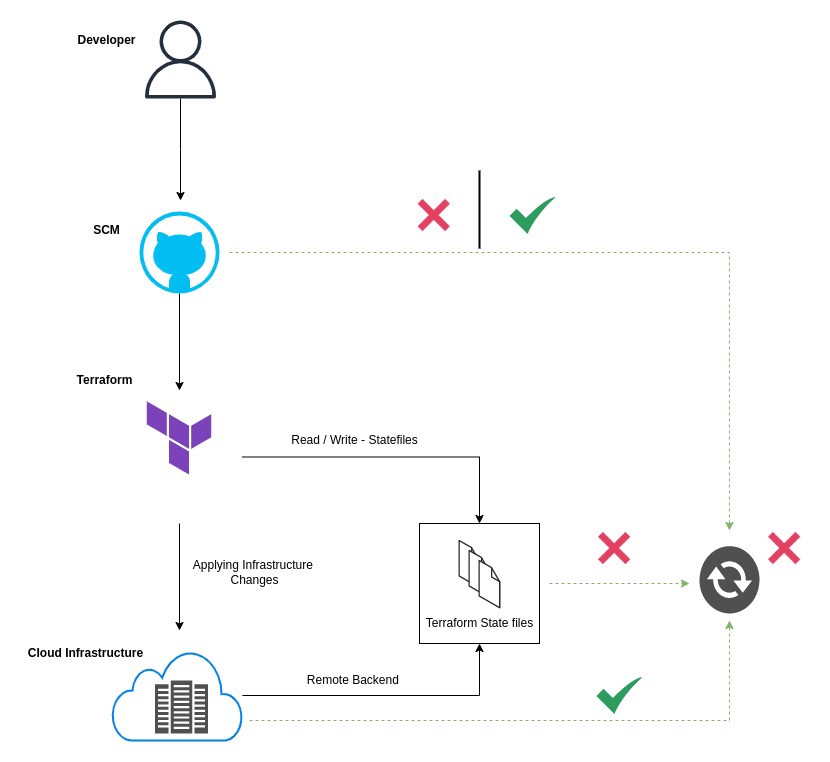This article intends to provide insight into the native approach of doing Terraform to import the cloud resources into the terraform state file which might reside in your local system / remote back-end.
Before get started, Let’s go through some of the concepts,
What is the purpose of the state file?
Terraform must store state about your managed infrastructure and configuration. This state is used by Terraform to map real world resources to your configuration, keep track of metadata, and to improve performance for large infrastructures. This state is stored by default in a local file named “terraform.tfstate”, but it can also be stored remotely, which works better in a team environment.
How does terraform state management work in most cases?
1. The developers could update the desired infrastructure changes in the terraform configuration files that reside under any SCM.
2. As soon as the new changes are committed to the repository, there could be an automated pipeline that will be triggered to perform a set of terraform operations.
3. Those terraform operations could be read/write state files to make the desired changes that were mentioned in the SCM after applying those changes in the infrastructure.
4. In the end, all will be in sync including the configuration files in SCM, terraform state files, and the infrastructure changes.
This is Awesome, but how about your use-case is slightly different like below:
1. There is a correct / missing terraform configuration files in SCM.
2. The infrastructure changes are already done manually due to some reasons.
3. Both of the above pieces of information is not even present in the terraform state files.
Here, the result will be out of sync, and some level of manual intervention is required to make everything in sync together. You could leverage these fixes using terraform import and the state management by going through the below concept:
The primary purpose of Terraform state is to store bindings between objects in a remote system and resource instances declared in your configuration. When Terraform creates a remote object in response to a change of configuration, it will record the identity of that remote object against a particular resource instance, and then potentially update or delete that object in response to future configuration changes.
Okay, that’s all the theory part — Following are the tool sets that we are using for the sake of quick demonstration, these could be leveraged to specific versions according to your use cases which doesn’t matter whether the state file is configured as local/remote back-end.
“Take a note that, in real-life scenarios- it isn’t just a bunch of updates/changes while running terraform plan phase, instead it returns something that you have to destroy resources first before making any changes/updates. This is where you have to be more cautious and update the state file with most care by importing each object. You can solve those problems with the given approach.”
Let’s dive into the practical way of doing this.
1.Assume that, we have two people — Sam & Sandy.
2. Sam created a Resource group in Azure by following tags using Terraform.
3. After the terraform operation such as ‘init, plan and apply’ — the resource group has been successfully created in Azure.
4. Sandy noticed that whatever the resources comes under this Resource group should be billable. But Sandy wasn’t aware that the change has to be done through Terraform. Instead, Sandy updated these changes manually from Azure portal and added extra 7 more tags as well.
5. Sandy informed these changes to Sam.
6. Sam run the ‘terraform plan’ phase with the current configuration file (main.tf) to understand Sandy’s changes and requested Sandy to make any further changes only through Terraform going forward.
7. Sam decided to import this resource group to make everything in sync together (including the configuration files in SCM, terraform state files, and the infrastructure changes).
8. Sam run the following terraform actions before start importing,
9. Sam understands that the object (azurerm_resource_group.this) that needs to be imported is using the resource module ‘azurerm_resource_group’. Hence, Sam looked at the documentation and analyzed that this object can be imported via the following dummy configuration file which doesn’t require to pass any arguments (such as ‘name, location, etc).
10. Let’s import via the following terraform actions and verify those information's,
11. Perfect !!! Now, we have the old and new information's of the state file. Sam is going to overwrite the imported state information's (terraform.tfstate) with the old one (terraform.tfstate-backup) which was renamed earlier.
12. At this point of time, Sam is successfully synced the state file.
13. Sam removed the dummy configuration file (main-dummy.tf) and renamed the old configuration file (main.tf-backup) how it was before. After that, Sam runs the ‘terraform plan’ phase, but the result is still showing there are changes/updates.
Why Because? Even though you sync the state file, terraform still looks for your configuration file and returns the results of what needs to be changed / not by comparing it with the existing information defined in the state file. Hence, it is important that you have to update the same information in both the state file (terraform.tfstate) and the configuration files (main.tf) to keep everything in sync.
14. Sam updated the respective changes in the configuration file (main.tf) as well.
15. Finally, Sam run the plan phase and make sure everything is in sync.
So, that’s it. If steps are known, there is plenty of ways to automate, I am leaving that to YOU !!! Happy Terraforming !!!
If you like this piece of information, please support me with your gesture as a followers and the claps.
Start blogging about your favorite technologies, reach more readers and earn rewards!
Join other developers and claim your FAUN account now!
User Popularity
17
Influence
2k
Total Hits
1
Posts













Only registered users can post comments. Please, login or signup.